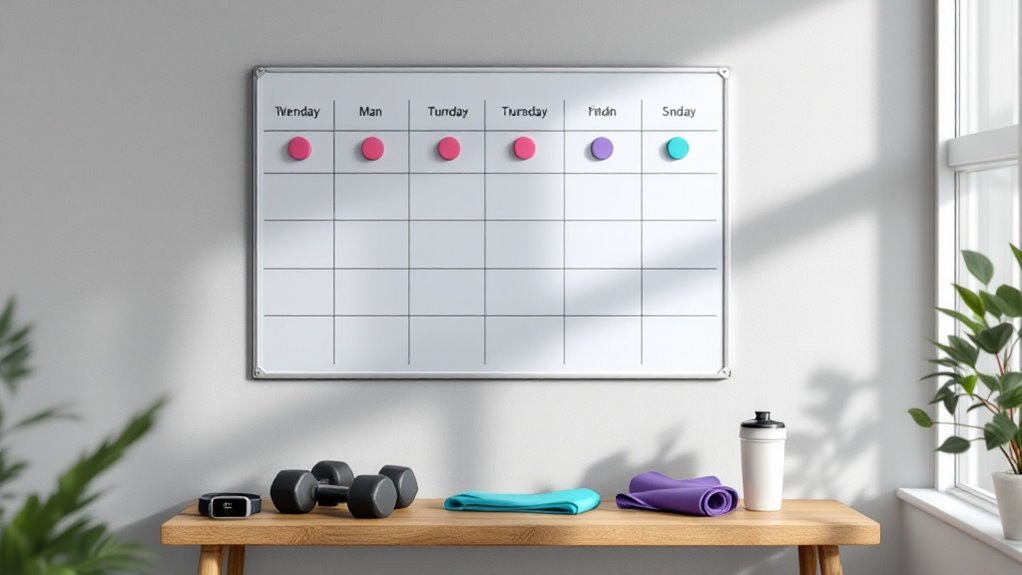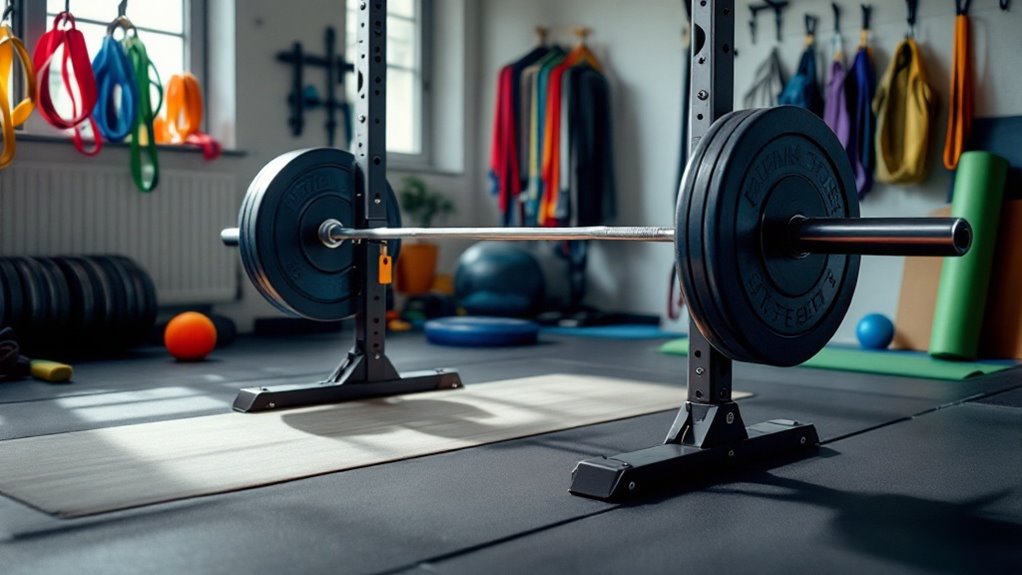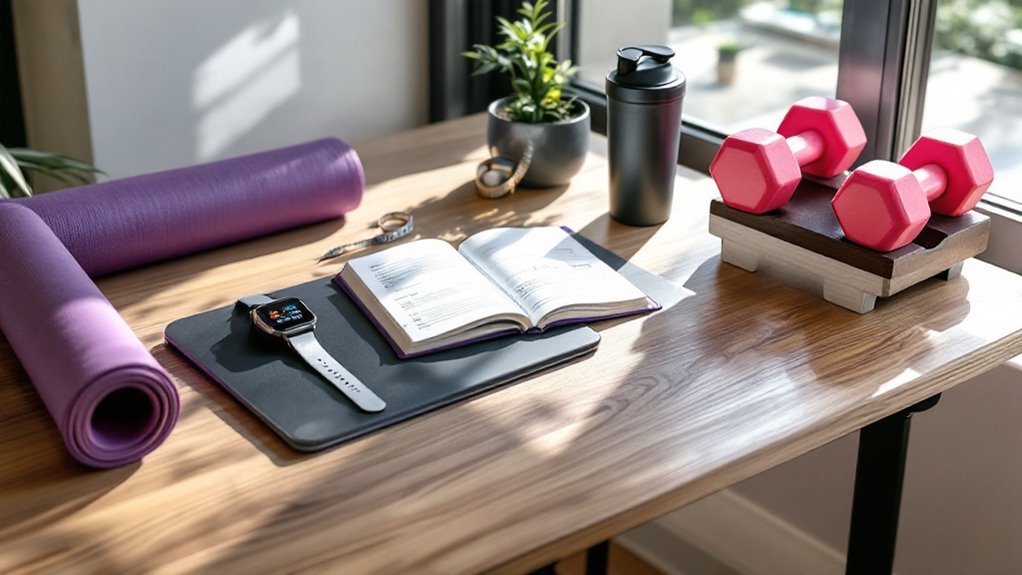Female Weight Lifting Schedule

A female weight lifting schedule should include 3-4 training sessions per week, focusing on full-body workouts or upper/lower splits. Women's higher endurance capacity allows for shorter rest periods between sets and increased training volume. Essential exercises include squats, deadlifts, bench presses, and overhead presses. Progress tracking through training logs and measurements guarantees ideal results. Smart watch data and recovery metrics help fine-tune the program's effectiveness. The journey to strength begins with understanding the fundamentals.
Key Takeaways
- Start with 3-4 training days per week, incorporating full-body workouts or upper/lower splits for optimal strength development.
- Schedule rest days between training sessions to allow proper muscle recovery and prevent overtraining.
- Focus on compound exercises like squats, deadlifts, and bench presses during each workout session.
- Train major muscle groups twice per week, using shorter rest periods between sets than male counterparts.
- Structure workouts to include 3-4 sets per exercise with 8-12 repetitions for muscle development and strength gains.
Understanding the Female Body and Weight Training

Women's bodies respond differently to weight training compared to men's bodies due to fundamental physiological differences in hormones, muscle fiber composition, and metabolism.
These distinctions require a specialized approach to strength training that optimizes results while working with female physiology.
The female body typically has higher body fat percentages, lower testosterone levels, and a greater ratio of type I muscle fibers.
This means women often excel at endurance activities and can generally handle higher training volumes with shorter rest periods.
Understanding these biological factors allows for the development of training programs that utilize women's natural strengths while systematically building power and muscle definition.
A well-designed strength training program helps women achieve improved bone density without developing excessive muscle mass.
Designing Your Weekly Training Split

Creating an effective weekly training split serves as the foundation for any successful strength training program. The ideal training schedule allows adequate recovery while maximizing strength gains and muscle development.
A strategic training split is essential for strength success, balancing optimal recovery periods with progressive overload for maximum results.
A well-designed split typically includes 3-4 training days per week for beginners, focusing on major muscle groups. Popular options include full-body workouts on alternating days or an upper/lower body split.
As strength increases, advanced lifters can progress to specialized splits like push/pull/legs or body-part specific training.
Rest days between sessions are vital for muscle recovery and preventing overtraining. The split should correspond with individual goals, schedule constraints, and fitness level.
Full body workouts are particularly beneficial for beginners to build foundational strength before progressing to more specialized training splits.
Essential Exercises and Proper Form

Since proper form and exercise selection create the foundation for strength training success, mastering key movements is essential for any female lifter. Core exercises include squats, deadlifts, bench presses, and overhead presses, which target major muscle groups efficiently.
Each movement requires strict attention to form. For squats, maintain a neutral spine while pushing through the heels.
During deadlifts, keep the bar close to the body and activate the lats.
Bench pressing demands shoulder blade retraction and controlled bar path.
Overhead pressing relies on core stability and proper shoulder positioning.
Master these fundamentals before adding weight or complexity to prevent injury and enhance results.
Following a structured progressive overload approach ensures continued strength development while maintaining proper technique.
Recovery and Progress Tracking

Proper recovery between training sessions determines the effectiveness of any strength program and drives consistent progress. Recovery includes not only adequate rest between workouts but also proper nutrition, sleep, and stress management.
Female lifters should track their progress using a training log that records weights, sets, reps, and perceived exertion for each exercise. Taking progress photos and measurements monthly helps visualize changes. Smart watch data and recovery metrics like resting heart rate and sleep quality provide additional insights.
Signs of good recovery include stable energy levels, consistent strength gains, and minimal joint pain. Adjusting training intensity based on recovery markers guarantees sustainable progress. Regular monitoring of muscle definition changes is another reliable indicator that your training program is yielding results.
Frequently Asked Questions
Should I Take Pre-Workout Supplements Before Weight Training?
Pre-workout supplements can provide benefits like increased energy, focus, and endurance during training sessions. However, they're not essential for success.
Natural alternatives like black coffee, bananas, or green tea can offer similar effects. Those new to lifting should first establish consistent training habits and proper nutrition before considering pre-workout supplements, as they may mask fatigue signals or create dependency.
Can Weight Lifting Affect My Menstrual Cycle?
Powerful physical pursuits can potentially impact periods.
Weight training may cause temporary menstrual cycle changes due to hormonal fluctuations and stress on the body. While moderate exercise typically regulates cycles, intense lifting might lead to irregular periods or amenorrhea.
Athletes should monitor their cycles, maintain proper nutrition, and adjust training intensity if disruptions occur.
Consulting a healthcare provider is recommended if significant changes persist.
Will Lifting Weights Make Me Look Too Muscular?
Building noticeable muscle mass requires specific training, nutrition, and genetic factors.
Women typically don't develop bulky muscles due to lower testosterone levels. Weight training primarily creates lean, toned physiques while boosting metabolism and bone density.
Even dedicated female bodybuilders must follow strict protocols to achieve significant muscle growth. Regular weight training helps create defined, athletic bodies without excessive bulk – think more like athletes than bodybuilders.
What Should I Wear When Weight Training at the Gym?
Many gym-goers make the mistake of wearing inappropriate attire, compromising both safety and performance.
Proper weight training attire includes moisture-wicking, form-fitting clothes that allow full range of motion without being restrictive.
Essential items are breathable t-shirts or tank tops, comfortable shorts or leggings, supportive athletic shoes, and lifting gloves if desired.
Avoid loose clothing that could catch on equipment or impede movement.
How Do I Deal With Unwanted Attention at the Gym?
Unwanted attention at the gym can be handled through several effective strategies.
Wear headphones to discourage conversation and maintain focused body language.
Train with a workout partner for added security.
Report persistent harassment to gym management.
Position yourself near staff or security cameras.
Consider changing workout times to less busy hours.
Master confident, direct responses like "I'm here to train" when needed.
Final Thoughts
Like a butterfly emerging from its chrysalis, the journey of female weightlifting transforms both body and mind. Following a well-structured training program, focusing on proper form, and maintaining adequate recovery periods create the foundation for success. By tracking progress and staying consistent with workouts, women can achieve their strength goals while building confidence that extends far beyond the weight room.


